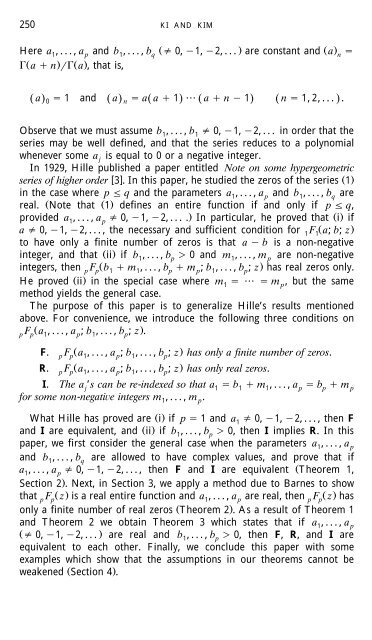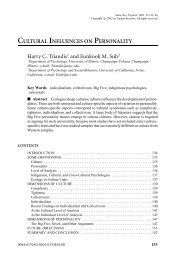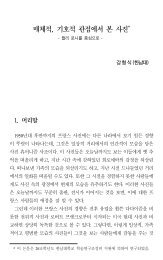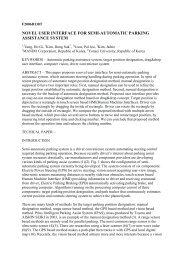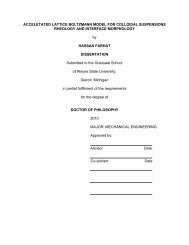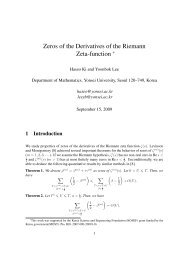On the Zeros of Some Generalized Hypergeometric Functions
On the Zeros of Some Generalized Hypergeometric Functions
On the Zeros of Some Generalized Hypergeometric Functions
Create successful ePaper yourself
Turn your PDF publications into a flip-book with our unique Google optimized e-Paper software.
250<br />
KI AND KIM<br />
Here a ,...,a and b ,...,b Ž 0, 1, 2, . . . . are constant and Ž a. 1 p 1 q n<br />
Ž a n. Ž a . , that is,<br />
Ž a. 0 1 and Ž a. n aŽ a1. Ž a n 1. Ž n 1,2,... . .<br />
Observe that we must assume b 1,...,b10, 1, 2, . . . in order that <strong>the</strong><br />
series may be well defined, and that <strong>the</strong> series reduces to a polynomial<br />
whenever some aj is equal to 0 or a negative integer.<br />
In 1929, Hille published a paper entitled Note on some hypergeometric<br />
series <strong>of</strong> higher order 3 . In this paper, he studied <strong>the</strong> zeros <strong>of</strong> <strong>the</strong> series Ž. 1<br />
in <strong>the</strong> case where p q and <strong>the</strong> parameters a 1,...,a p and b 1,...,bq are<br />
real. ŽNote that Ž 1. defines an entire function if and only if p q,<br />
provided a ,...,a 0, 1, 2, . . . . . In particular, he proved that Ž i. 1 p<br />
if<br />
a 0, 1, 2, . . . , <strong>the</strong> necessary and sufficient condition for F Ž a; b; z.<br />
1 1<br />
to have only a finite number <strong>of</strong> zeros is that a b is a non-negative<br />
integer, and that Ž ii. if b 1,...,bp 0 and m 1,...,m p are non-negative<br />
integers, <strong>the</strong>n F Ž b m ,...,b m ; b ,...,b ; z. p p 1 1 p p 1 p has real zeros only.<br />
He proved Ž ii. in <strong>the</strong> special case where m1 m p,<br />
but <strong>the</strong> same<br />
method yields <strong>the</strong> general case.<br />
The purpose <strong>of</strong> this paper is to generalize Hille’s results mentioned<br />
above. For convenience, we introduce <strong>the</strong> following three conditions on<br />
F Ž a ,...,a ; b ,...,b ; z . .<br />
p p 1 p 1 p<br />
F. F Ž a ,...,a ; b ,...,b ; z. p p 1 p 1 p has only a finite number <strong>of</strong> zeros.<br />
R. F Ž a ,...,a ; b ,...,b ; z. has only real zeros.<br />
p p 1 p 1 p<br />
I. The a ’s can be re-indexed so that a b m ,...,a b m<br />
j 1 1 1 p p p<br />
for some non-negatie integers m ,...,m .<br />
1 p<br />
What Hille has proved are Ž. i if p 1 and a1 0, 1, 2, . . . , <strong>the</strong>n F<br />
and I are equivalent, and Ž ii. if b ,...,b 0, <strong>the</strong>n I implies R. In this<br />
1 p<br />
paper, we first consider <strong>the</strong> general case when <strong>the</strong> parameters a 1,...,a p<br />
and b 1,...,bq are allowed to have complex values, and prove that if<br />
a ,...,a 0, 1, 2, . . . , <strong>the</strong>n F and I are equivalent Ž<br />
1 p<br />
Theorem 1,<br />
Section 2 . . Next, in Section 3, we apply a method due to Barnes to show<br />
that F Ž z. is a real entire function and a ,...,a are real, <strong>the</strong>n F Ž z. p p 1 p p p has<br />
only a finite number <strong>of</strong> real zeros Ž Theorem 2 . . As a result <strong>of</strong> Theorem 1<br />
and Theorem 2 we obtain Theorem 3 which states that if a ,...,a<br />
1 p<br />
Ž 0, 1, 2, . . . . are real and b 1,...,bp 0, <strong>the</strong>n F, R, and I are<br />
equivalent to each o<strong>the</strong>r. Finally, we conclude this paper with some<br />
examples which show that <strong>the</strong> assumptions in our <strong>the</strong>orems cannot be<br />
weakened Ž Section 4 . .


